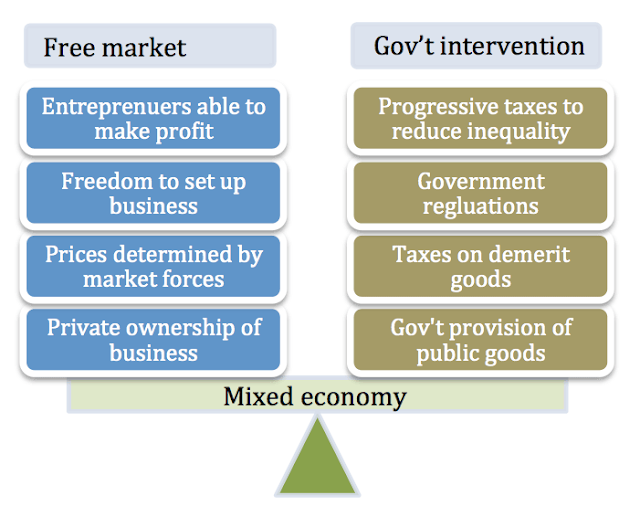Economy - Full Explanation & Example
An economy (from Greek οίκος – "household" and νέμoμαι – "manage") is an area of the production, distribution, or trade, and consumption of goods and services
by different agents. Understood in its broadest sense, 'The economy is
defined as a social domain that emphasizes the practices, discourses,
and material expressions associated with the production, use, and
management of resources'. Economic agents can be individuals, businesses, organizations, or
governments. Economic transactions occur when two parties agree to the
value or price of the transacted good or service, commonly expressed in a
certain currency. However, monetary transactions only account for a small part of the economic domain.

Economic activity is spurred by production which uses natural resources, labor, and capital. It has changed over time due to technology (automation, accelerator of process, reduction of cost functions), innovation
(new products, services, processes, expanding markets, diversification
of markets, niche markets, increases revenue functions) such as, that
which produces intellectual property and changes in industrial relations (for example, child labor being replaced in some parts of the world with universal access to education).A given economy is the result of a set of processes that involves its culture, values, education, technological evolution, history, social organization, political structure and legal systems, as well as its geography, natural resource endowment, and ecology, as main factors. These factors give context, content, and set the conditions and parameters in which an economy functions. In other words, the economic domain is a social domain of human practices and transactions. It does not stand alone.
A market-based economy is where goods and services are produced and exchanged according to demand and supply between participants (economic agents) by barter or a medium of exchange with a credit or debit value accepted within the network, such as a unit of currency.
A command-based economy is where political agents directly control what is produced and how it is sold and distributed.
A green economy is low-carbon, resource efficient, and socially inclusive. In a green economy, growth in income and employment are driven by public and private investments that reduce carbon emissions and pollution, enhance energy and resource efficiency, and prevent the loss of biodiversity and ecosystem services.
Traditional economy
Traditional economy is an original economic system in which traditions, customs, and beliefs help shape the goods and the services the economy produces, as well as the rules and manner of their distribution. Countries that use this type of economic system are often rural and farm-based. Also known as a subsistence economy, a traditional economy is defined by bartering and trading. A little surplus is produced and if any excess goods are made, they are typically given to a ruling authority or landowner.A pure traditional economy has had no changes in how it operates (there are few of these today). Examples of these traditional economies include those of the Inuit or those of the tea plantations in South India. Traditional economies are popularly conceived of as "primitive" or "undeveloped" economic systems, having tools or techniques seen as outdated.As with the notion of contemporary primitiveness and with modernity itself, the view that traditional economies are backward is not shared by scholars in economics and anthropology. One example of a traditional or custom based economy is Haiti.
Traditional economies may be based on custom and tradition, with economic decisions based on customs or beliefs of the community, family, clan, or tribe.
Market Economy
A market economy is an economic system in which the decisions regarding investment, production, and distribution are guided by the price signals created by the forces of supply and demand. The major characteristic of a market economy is the existence of factor markets that play a dominant role in the allocation of capital and the factors of production.
Market economies range from minimally regulated "free market" and laissez-faire systems—where state activity is restricted to providing public goods and services and safeguarding private ownership to interventionist forms where the government plays an active role in correcting market failures and promoting social welfare. State-directed or dirigist economies are those where the state plays a directive role in guiding the overall development of the market through industrial policies or indicative planning which guides but does not substitute the market for economic planning a form sometimes referred to as a mixed economy.
Market economies are contrasted with planned economies where investment and production decisions are embodied in an integrated economy-wide economic plan by a single organizational body that owns and operates the economy’s means of production.
What is a 'Command Economy'
A command economy is a system where the government, rather than the free market, determines what goods should be produced, how much should be produced and the price at which the goods are offered for sale. It also determines investments and incomes. The command economy is a key feature of any communist society. Cuba, North Korea and the former Soviet Union are examples of countries that have command economies, while China maintained a command economy for decades before transitioning to a mixed economy that features both communistic and capitalistic elements.
Mixed economy
A mixed economy is variously defined as an economic system blending elements of market economies with elements of planned economies, free markets with state interventionism, or private enterprise with public enterprise. There is not only one definition of a mixed economy, but there are two major definitions recognized for "mixed economy". The first of these definitions refers to a mixture of markets with state interventionism, referring to capitalist market economies with strong regulatory oversight, interventionist policies and governmental provision of public services. The second definition is apolitical in nature and strictly refers to an economy containing a mixture of private enterprise with public enterprise.In most cases and particularly with reference to Western economies, a mixed economy refers to a capitalist economy characterized by the predominance of private ownership of the means of production with profit-seeking enterprise and the accumulation of capital as its fundamental driving force. In this system, markets are subject to varying degrees of regulatory control and governments wield indirect macroeconomic influence through fiscal and monetary policies designed to counteract capitalism’s history of boom/bust cycles, unemployment and income disparities. In this framework, varying degrees of public utilities and essential services are under public ownership and state activity is often limited to providing public goods and universal civic requirements like healthcare, physical infrastructure and management of public lands.
In reference to post-war Western and Northern European economic models as championed by Christian democrats and social democrats, the mixed economy is defined as a form of capitalism where most industries are privately owned with only a small number of public utilities and essential services under public ownership. In the post-war era, European social democracy became associated with this economic model.As an economic ideal, mixed economies are supported by people of various political persuasions, typically center-left and center-right, such as social democrats or Christian democrats.
A mixed economy can also refer to socialist economies with a substantial role for non-social or non-public forms of ownership in the means of production, or to Soviet-type planned economies that have been reformed to allow a greater role for market forces.













0 Comments